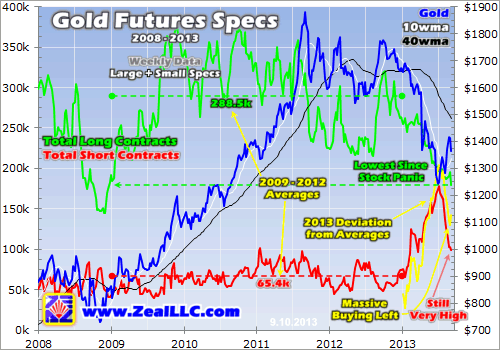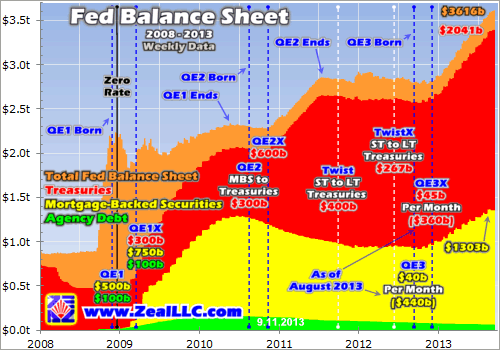Gold & Precious Metals
“Just as the monetary indicators are turning positive [for gold],” said HSBC in a report Thursday, “physical demand – a mainstay of the market through the summer – is turning less supportive.”
Reuters today notes a sharp fall this week in Asian premiums for physical gold, over and above benchmark London prices.
Hong Kong premiums fell to $1.50 per ounce from $2.50, the newswire says. Tokyo gold went to a slight discount to London settlement.
“There has only been investment buying because of the Fed decision,” says Hong Kong dealer Ronald Leung at Lee Cheong Gold. “There is no physical interest” from jewelry stockists.
The Implications Are Staggering – Especially For Gold
Posted by Adam Hamilton - Zeal Intelligence
on Friday, 20 September 2013 19:44
“The Federal Reserve shocked the financial world this week, defying universal expectations”
Ed Note:This is a thorough analysis of the Fed’s decision, especially as it relates to Gold. There are two great charts I have enclosed below and a lot of links to support his judgement and declarations. Click on either chart or the title of his article Fed Unleashes Gold below to read this long and detailed article:
The markets reacted swiftly to the news of the Federal Reserve’s FOMC’s decision to not taper their asset purchases at their September meeting. The press conference following the policy announcement expanded on this to give the impression that the US Fed lacks confidence in the economic recovery to be able to pare back their extraordinary stimulus. While some question the Fed’s credibility at this point and see Bernanke as a repeat offender for shocking financial markets, there could be other shifts going on at the Fed that have caused them to make this decision.
Earlier this year, it created a huge turn in financial markets when the Fed announced that they begin the withdrawal of their asset purchases later in the year. Immediately there was a huge selloff in all markets spanning from equities to bonds to commodities. The only asset for some stability was the US dollar. That helps explain the reaction Wednesday, when the markets took the complete opposite reaction to the Fed’s decision to delay the much anticipated taper. And if Chairman Bernanke tried his best to make clear one single point, it was that the Fed’s decision to taper was and always has been dependent on the economic data. Despite analysts and financial media over-interrupting his press conferences and meeting minutes, data indicating an improvement in the underlying US economy will allow the Fed to taper. Wednesday signalled that day is not yet here.
The job market had provided the best indication for market analysts for the direction of Fed policy. That is why, in an economic recovery, when those numbers are released each month so much weight goes to what they reveal. In this newsletter a few weeks back, discussing August’s weak payroll report, I suggested this could give voting members uncertainty about the upcoming decision to taper, and create the potential for a few months delay, and that is exactly what we saw. Where the Fed used the unemployment rate as yardstick for the quantity of asset purchases to be made on a monthly basis, they realized that their yard stick was no longer the right measuring tool for the State’s economic performance.
Bernanke cited problems with US job creation. Particularly as we enter a period of decreasing labour force participation, and a retiring boomer population that is not being replaced by a workforce with the same skill set. Thus an unemployment rate of 7 percent to allow for tapering asset purchases looks more like some arbitrary goal than one of actual substance. Better signs for the US employment front can be found in the 4 week moving average of weekly jobless claims as that number indicates almost 40 thousand fewer Americans file for unemployment benefits on a weekly basis as did 4 months ago; however, job creation is the foremost issue, and there are still 7 million Americans either under or unemployed since the peak before this crisis began.
Going forward, it’s truly important that investors make themselves cognisant of two issues. These encompass the realm of possibilities in decisions that could come from the US Fed. Tapering can occur at any instance between now and the Fed’s next meeting. It may not, but eventually the taper is inevitable. This could throw a bit of a curveball at the markets. Despite the Fed’s asset purchases as of late being more impactful on sentiment, any announcement regarding change (or lack thereof) can act as a shock to the financial system.
The second is that investors may want to position themselves for an even more dovish Federal Reserve. While some argue Bernanke went back on his word or misled investors, I would suggest (with full credit to Pimco’s Bill Gross) that the shift is beginning to see Fed Vice-Chair Janet Yellen’s influence increase even more. Thus, this is why the market priced in her leadership overseeing the Fed Funds rate unchanged for a longer time horizon.
Although there are many uncertainties, one thing is clear; despite the Fed’s increased transparency and despite their efforts to provide forward guidance—against all efforts to the contrary they still have the ability to send financial markets for a tailspin.
Click here to view the original article.
.The bottom line about all this is that by definition these are not actual markets where prices are fairly discovered by supply and demand factors. Instead, they are profit centers which the bullion banks regularly milk for their own benefit and profit.
The futures markets also act as displays or window dressing for a much larger underlying fiat currency crisis that remains hidden just beneath the surface.
How long this manipulative charade can go on is up to the thinnest sentiment in existence — confidence underpinned by human emotion.
….read it all HERE
It was not too surprising that there is going to be no tapering for some very good reasons. The commencement of tapering would have led deliberately to bond yields rising, triggered by an increase in sales of government bonds to the public and at the same time escalating sales by foreign governments as they attempt to retain control over their own currencies and interest rates. This was the important lesson from floating the rumour of tapering in recent months.
The reason tapering was not going to happen is summarised as follows:
- Monetarists and therefore central bankers believe that rising bond yields and interest rates will strangle economic recovery. They want to see more robust evidence of recovery before permitting that to happen.
- Rising bond yields would have required the Fed to raise interest rates sooner rather than later to stem the flight of bank deposits from the Fed’s own balance sheet held as excess reserves, which only earn 0.25%.
- Importantly, the global banking system has too much of its collective balance sheet invested in fixed-interest bonds, and is also exposed to rising interest rates through interest rate swap derivatives. Tapering would almost certainly have precipitated a second bank crisis starting at the system’s weakest point.
- The cost of funding the US Government’s deficit would have risen, difficult when the debt ceiling has to be renegotiated yet again.
- Rising US interest rates will most probably destabilise emerging market currencies, risking a new Asian crisis.
- It is a bad time to shift the burden of government funding back into the markets, because foreign holders have shown they will sell into rising yields.
The Fed has reaffirmed that zero interest rates will be with us for some time to come. It simply has no choice: it has to play down the risk of inflation. The result will be more price inflation, which is bad for the dollar and good for gold. This was reflected in the US Treasury yield curve, where prices of long maturities fell yesterday relative to the short end.
The markets had wrongly talked themselves into believing that tapering was going to happen, when the rumour was no more than an experiment. In the process precious metals were sold, driven by increasingly bearish technical talk every time a support level was breached. It is hardly surprising therefore that the recovery in gold and silver prices last night was dramatic, with gold moving up $70 and silver by $2 from intra-day lows. It looks like a significant second bottom is now in place above the June lows and the bear position, coupled with the shortage of physical metal will drive prices in the coming weeks.
The implications of the Fed not going ahead with tapering are bad for the dollar and won’t stop bond yields at the long end from rising. It shows that the whole US economy is in a massive debt trap that cannot be addressed for powerful reasons. The reality is the expansion of cash and deposits in the US banking system is tending towards hyperinflation and is proving impossible to stop. That is the message from this week’s FOMC meeting, and I expect it to gradually dawn on investors world-wide in the coming weeks.
About the Author
Alasdair Macleod is head of research for GoldMoney. He also runs FinanceAndEconomics.org, a website dedicated to sound money and demystifying finance and economics. He has a background as a stockbroker, banker and economist. He can be contacted at Alasdair.Macleod@GMYF.org and followed on Twitter @MacleodFinance.Alasdair Macleod
-
I know Mike is a very solid investor and respect his opinions very much. So if he says pay attention to this or that - I will.
~ Dale G.
-
I've started managing my own investments so view Michael's site as a one-stop shop from which to get information and perspectives.
~ Dave E.
-
Michael offers easy reading, honest, common sense information that anyone can use in a practical manner.
~ der_al.
-
A sane voice in a scrambled investment world.
~ Ed R.
Inside Edge Pro Contributors

Greg Weldon

Josef Schachter

Tyler Bollhorn

Ryan Irvine

Paul Beattie

Martin Straith

Patrick Ceresna

Mark Leibovit

James Thorne

Victor Adair





